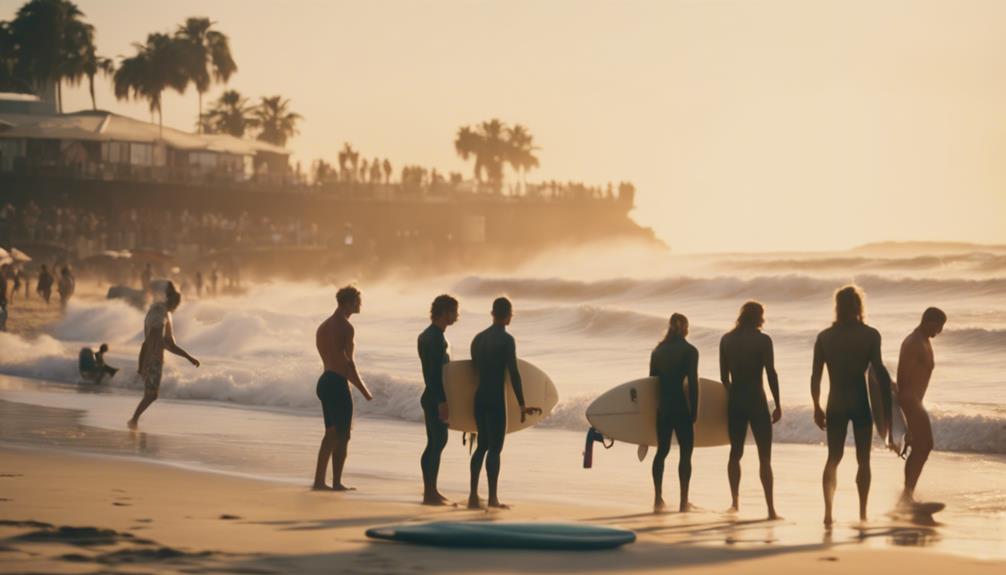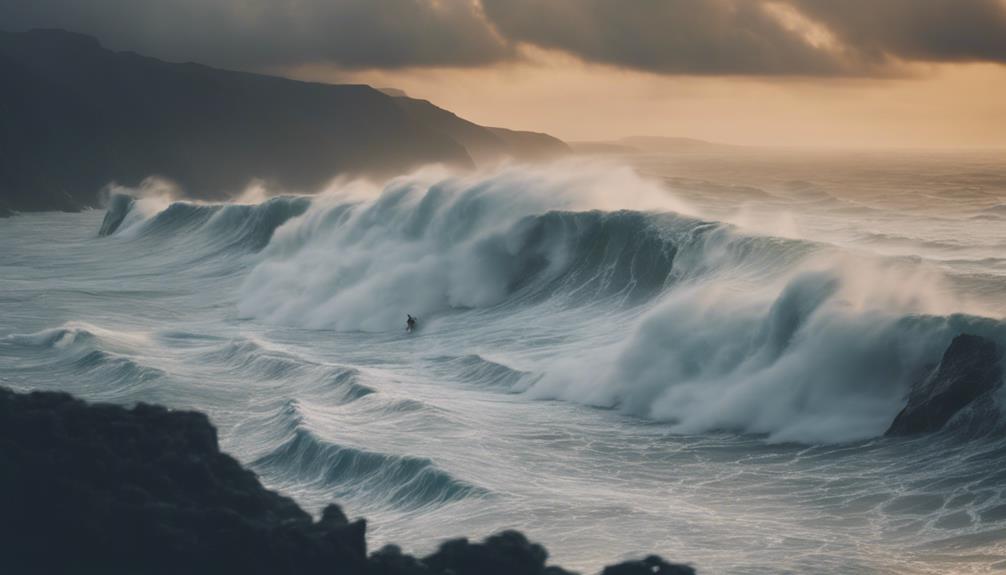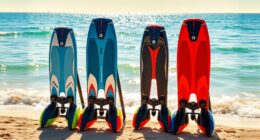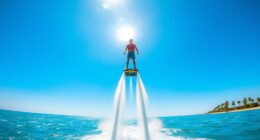California's coastline is a surfer's paradise, with the best waves spread across three main regions. In Southern California, you'll find iconic spots like Malibu for beginners, Huntington Beach for events, and Trestles for all skill levels. The Central Coast boasts Santa Cruz, perfect for intermediate surfers, while Northern California's Mavericks challenges the experienced with powerful swells. Fall's ideal conditions attract surfers year-round, making it the perfect time to ride the waves. Whether you're a novice or a pro, California's surf culture offers something for everyone—get ready to explore what else the Golden State has for you!
Key Takeaways
- Southern California features iconic surf spots like Malibu, Huntington Beach, and Trestles, catering to all skill levels year-round.
- Central Coast offers powerful waves in areas like Santa Cruz, ideal for intermediate and advanced surfers during fall, winter, and spring.
- Northern California, particularly Mavericks, challenges expert surfers with massive winter swells and colder water temperatures requiring thick wetsuits.
- Fall is considered the best surf season in California, combining favorable swells and optimal conditions for all surfers.
Overview of California Surfing
California surfing offers an exhilarating experience with its diverse coastline and iconic waves that cater to surfers of all skill levels. With 840 miles of stunning shoreline, you'll find a variety of surf spots that showcase different wave types, from mellow rollers to challenging barrels.
Southern California, in particular, is a surfing paradise, providing year-round access to surfable waves and warm ocean temperatures ranging from 52°F in winter to 74°F in late summer.
The state is divided into three main surfing regions: Southern California, Central Coast, and Northern California. Each region offers unique conditions and experiences. While Southern California is known for its reliable swells and vibrant surf culture, Northern California presents more challenging waters, ideal for experienced surfers seeking a thrill.
Key surfing seasons in California include winter for consistent swells, summer for warmer waters and increased crowds, and fall, which often delivers the best overall conditions thanks to a mix of swells and favorable winds.
Whether you're a beginner or a seasoned pro, California's diverse surf landscape guarantees you'll find the perfect wave to ride and enjoy the rich local culture that surrounds it.
Southern California Surf Spots
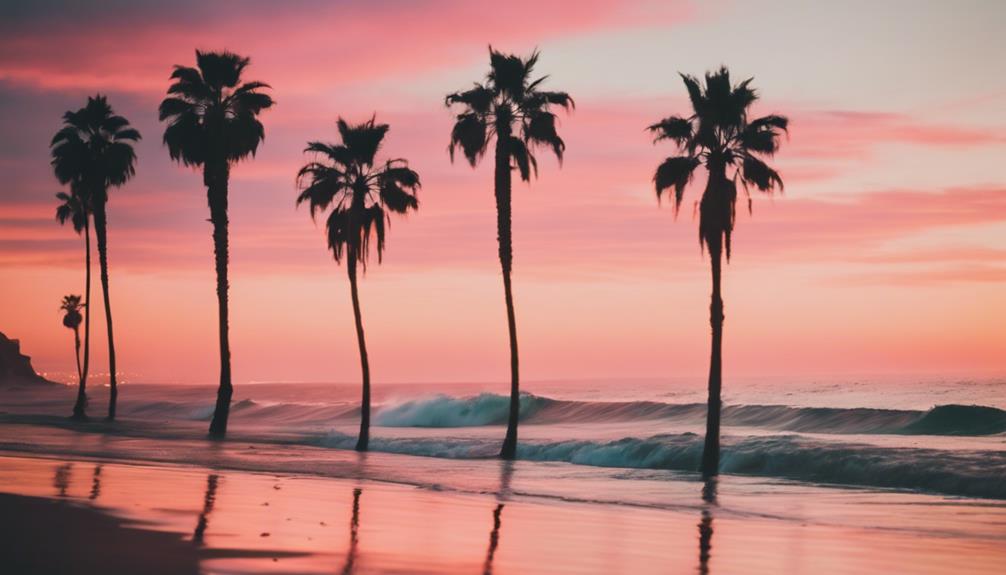
Southern California's surf spots are a must-visit for any surfer looking to catch some epic waves.
You'll find everything from the iconic breaks at Malibu to the vibrant surf culture in Encinitas.
With ideal conditions and a variety of locations, there's something for everyone, regardless of your skill level.
Popular Surf Locations
From the bustling beaches of Huntington to the iconic waves of Malibu, Southern California offers some of the most popular surf spots that cater to every skill level.
Huntington Beach, known as 'Surf City USA,' boasts consistent waves and hosts the annual US Open of Pro Surfing, making it a must-visit surf destination. If you're looking for a picturesque experience, Malibu's long, slow right-hand waves are perfect for longboarders and beginners alike.
For those seeking more challenging conditions, Trestles in San Clemente is renowned for its world-class waves that attract both advanced and beginner surfers. The scenic views enhance your surfing adventure, creating a perfect day at the beach.
La Jolla, with its vibrant surf community, features diverse breaks, including the popular Windansea Beach, which offers a range of waves suitable for all levels.
Ideal Surf Conditions
When you're hunting for ideal surf conditions, Southern California's diverse beaches offer something for every surfer, regardless of skill level. With year-round opportunities and consistent wave breaks, you'll find spots that cater to both beginners and experts alike. The ocean temperature ranges from 52°F in winter to 74°F in late summer, ensuring comfortable sessions throughout the year.
Here's a quick overview of some of the best surf spots:
| Surf Spot | Ideal Conditions | Notable Features |
|---|---|---|
| Huntington Beach | South swells in summer | Legendary surf competitions |
| Trestles | Year-round consistency | Varied wave challenges |
| Malibu | Long, slow right point breaks | Perfect for beginners |
| Carlsbad | Warm water and south swells | Great summer sessions |
| San Onofre | Fall swells and offshore winds | Advanced surfing options |
Fall is often regarded as the best season for surf trips due to the combination of SW and W swells, making it ideal for catching those legendary waves. Whether you're just getting started or looking to tackle bigger challenges, Southern California has you covered.
Surf Culture Highlights
California's surf culture thrives in iconic spots like Malibu and Huntington Beach, where vibrant communities celebrate the sport and its lifestyle year-round. Surfing in California isn't just a pastime; it's a way of life.
At Huntington Beach Pier, known as 'Surf City USA,' you'll find a bustling scene with surfers of all levels tackling waves, especially during events like the US Open of Pro Surfing. This annual competition highlights the talent and passion that defines the area.
Trestles, another gem in Southern California's surf scene, offers a variety of wave types, making it a favorite among both beginners and advanced surfers. Whether you're chasing big waves or enjoying mellow swells, you'll experience the essence of California surf culture.
The warm ocean temperatures, ranging from 52°F in winter to 74°F in summer, allow for year-round surfing, so don't hesitate to grab your board.
In Southern California, surf shops, schools, and local legends all contribute to an environment where the spirit of California is one with the ocean. Immerse yourself in this dynamic culture, and you'll quickly understand why surfing here is an unforgettable experience.
Central Coast Surfing Highlights
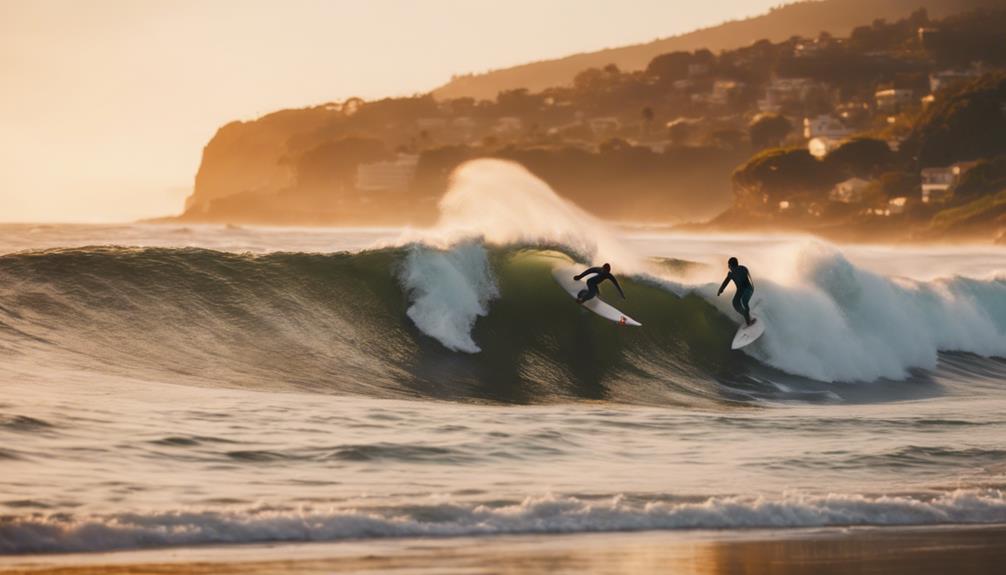
The Central Coast offers a fantastic array of surf spots that cater to both intermediate and advanced surfers, all set against stunning coastal backdrops. From Ventura County up to Santa Cruz, you'll find diverse surf breaks that range from the thrilling waves of Steamer Lane to the more relaxed atmosphere at Pismo Beach and Avila Beach.
If you're seeking consistent swells, fall, winter, and spring are the best seasons to ride the waves, as they provide ideal conditions and fewer crowds.
Santa Cruz stands out as a highlight, renowned for its powerful waves that challenge even seasoned surfers. The area's unique coastal geography, featuring rugged cliffs and lush kelp forests, creates varying wave conditions, ensuring you'll find something that suits your style.
As you immerse yourself in the local surf culture, you'll appreciate the laid-back vibe that permeates the beaches. Numerous surf schools and shops are available to help you refine your skills or even start your surfing journey.
Whether you're seeking thrill or tranquility, the Central Coast has everything you need for an unforgettable surfing experience.
Northern California Wave Challenges

Northern California's surf scene is renowned for its formidable waves, offering seasoned surfers a thrilling challenge that few other places can match. The area, especially spots like Mavericks, draws intermediate to advanced surfers enthusiastic to tackle its notorious, challenging surf conditions. Here, winter swells can tower up to 100 feet, creating an adrenaline rush that's hard to replicate elsewhere.
However, don't underestimate the region's colder temperatures, which typically range from 48°F to 62°F. You'll need a thick 5mm fullsuit, along with booties and gloves, to stay warm while maneuvering the powerful surf. The rugged coastline and unpredictable coastal winds further add to the complexity of the waves, meaning you must stay alert and aware of local weather and tide patterns.
While places like Stinson Beach and Bolinas offer stunning scenery and less crowded breaks, they still present unique challenges that are best suited for those with experience. If you're ready to take on the wild and often harsh elements of Northern California, you'll find a thrilling surfing experience that truly tests your skills.
Seasonal Surf Conditions
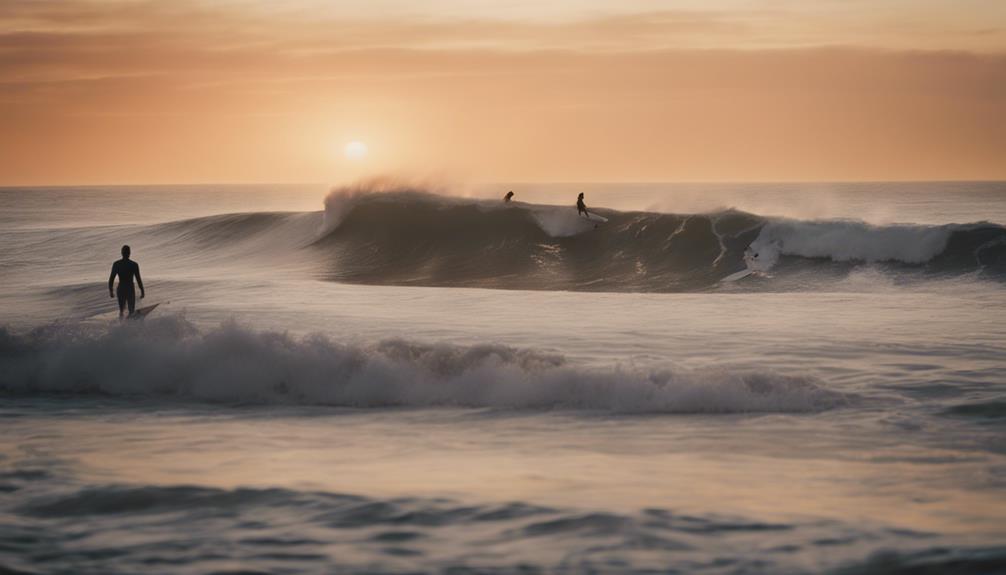
Surf conditions in California vary dramatically throughout the year, offering unique challenges and opportunities for surfers at every skill level.
During the winter months (November to February), you'll find the most reliable swell conditions, perfect for advanced surfers seeking the big waves at spots like Mavericks and Blacks Beach.
As spring rolls in (March to May), expect variable conditions with swells shifting from northwest to southwest, which can make planning surf sessions a bit tricky.
Summer (June to August) brings southern swells, where popular locations like Carlsbad and Ventura see consistent sets. If you want to avoid crowds, early morning sessions are your best bet.
As you head into fall (September to October), conditions improve with a mix of southwest and west swells, complemented by the offshore Santa Ana winds, making this the ideal time for surf trips.
Regardless of the season, California provides year-round surfing opportunities. Just remember that conditions and wave quality can change considerably by region and season, so keep an eye on local forecasts to maximize your surf experience.
Travel and Transportation Tips
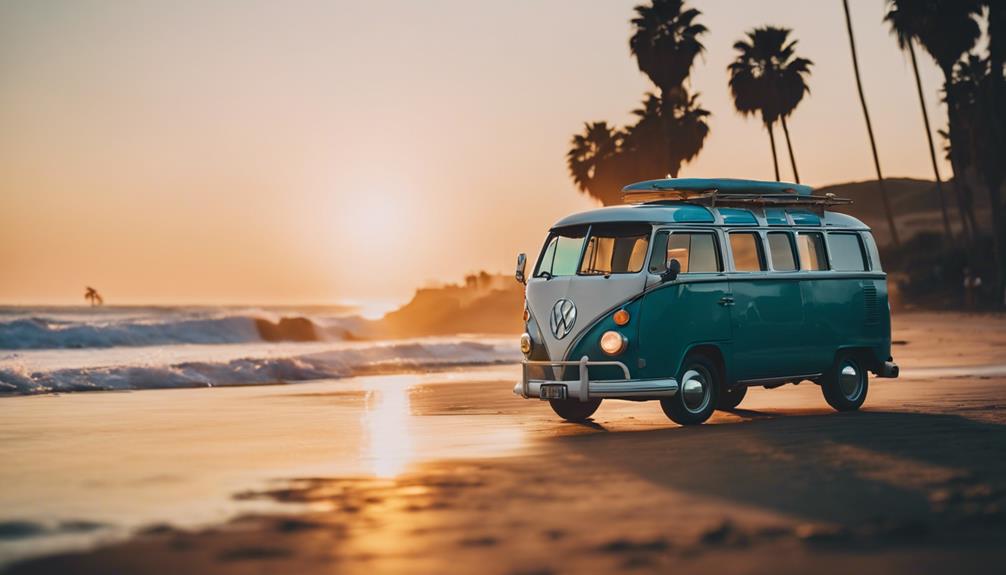
When you're planning your surf trip in California, renting a car or campervan gives you the freedom to explore various surf spots at your own pace.
Make sure to map out your travel itinerary along the scenic Highway 1, as it connects many of the best waves.
With some prep work, you can maximize your time in the water and enjoy the journey between breaks.
Car Rental Recommendations
Renting a car or campervan is crucial for exploring California's best surfing spots, giving you the flexibility to chase the waves on your own schedule.
With economy car rentals costing around $30-$35 per day and campervans ranging from $100-$200, it's wise to evaluate your budget and travel distances. For instance, driving from Santa Barbara to San Diego typically takes about 3-4 hours, so plan your travel time between surf locations carefully.
Public transportation options are limited, making a car your best bet for accessing those hidden surf gems. You might also think about rideshare services for short hops, but having your own vehicle will give you the greatest freedom.
To save money and guarantee availability, make certain to book your rental car early, especially during peak tourist seasons.
Don't forget that fuel costs will be your primary expense while driving, as there are few toll roads along the coastline. Budget for gas during your surf trip to avoid any surprises, and you'll be ready to enjoy the California waves without a hitch!
Navigating Coastal Highways
Maneuvering California's coastal highways offers breathtaking views and easy access to some of the best surfing spots in the state. To make the most of your trip, consider renting a car or campervan. Economy car rentals typically cost between $30-$35 a day, while campervans range from $100-$200, depending on the season. This flexibility allows you to explore various surf spots along the Pacific Coast Highway, which runs directly along the coastline.
Travel distances between popular locations, like Santa Barbara to San Diego, usually take about 3-4 hours. Planning your travel time is essential for maximizing surf sessions. While public transport options exist, they're limited along the coast. Rideshare services can supplement your rental car, providing added convenience when you want to explore local areas without driving.
If you're traveling during peak tourist seasons from June to early September, booking your rental car early is advisable to secure the best rates. With the right transportation, you can easily navigate California's stunning coastline and hit all the surf spots on your list. Enjoy the ride and the waves!
Planning Travel Itineraries
To maximize your surfing experience in California, carefully plan your travel itinerary to include key surf spots and efficient routes.
Renting a car or campervan is highly recommended for your surf trip, as it provides the flexibility to explore the coastline at your own pace. Rental costs typically range from $30-$35 per day for economy cars to $100-$200 for campervans, depending on the season.
Keep in mind that travel distances between major surf locations, like Santa Barbara and San Diego, can span 3-4 hours. Planning your stops can help guarantee you maximize your surf time without feeling rushed. Since public transport options are limited, having a car is essential for accessing various surf breaks along California's 840 miles of coastline.
Don't forget that fuel costs will be your primary expense, as few toll roads exist. It's wise to book your rental early during peak tourist seasons to secure the best rates.
Additionally, consider using rideshare services to complement your car rental, which can provide extra transportation options for reaching surf spots and local attractions.
Enjoy the ride and the waves!
Accommodation Options for Surfers

Finding the right accommodation can enhance your surfing experience in California, whether you prefer budget hostels or luxurious seaside hotels.
If you're on a tight budget, consider staying at one of the many budget hostels starting at just $50 per night. These spots keep you close to popular surf breaks without breaking the bank.
For a more social vibe, check out the surfhouse in Encinitas. Its retro atmosphere makes it a perfect place to meet fellow surfers and enjoy easy access to beach breaks.
If you're looking for something a bit more upscale, The Surfrider Malibu features surfer-friendly amenities and stunning views of Malibu First Point, ensuring you're just steps away from iconic surf.
The Huntington Surf Inn is another great option, conveniently located near Huntington Pier. Make sure to book early to secure one of those coveted ocean-view rooms.
If you're feeling adventurous, explore camping options along the Southern California coast. While free camping is limited, various campgrounds offer cost-effective accommodations, letting you stay close to the waves while enjoying the great outdoors.
Surf Culture and Local Attractions

California's surf culture thrives on its rich history and vibrant community, making it an unforgettable experience for both surfers and beachgoers alike. From the iconic beaches of Malibu to the bustling surf towns like Encinitas and San Diego, you'll find a lifestyle deeply intertwined with the ocean.
Here are some must-see attractions and experiences that define California's surf culture:
- US Open of Pro Surfing: Held annually in Huntington Beach, this event draws top surfers from around the world, showcasing epic waves and fierce competition.
- Local Surf Shops: Visit surf shops throughout California for gear, rentals, and lessons. These shops foster a supportive atmosphere for surfers of all skill levels.
- Surf Festivals: Events like those in Hermosa Beach celebrate the surfing lifestyle, engaging the community and drawing participants and spectators of all ages.
- Scenic Coastal Attractions: Explore stunning spots like Big Sur and the cultural offerings in Santa Cruz, which enhance your surfing experience with breathtaking views and recreational activities.
Immerse yourself in California's surf culture, and you'll leave with unforgettable memories!
Costs for a Surf Trip

A surf trip can cost you around $135 per day, including essentials like accommodation, car rental, and food. If you're looking to keep your daily expenses manageable, consider budget-friendly options to maximize your experience without breaking the bank.
| Expense Type | Budget Option | Luxury Option |
|---|---|---|
| Accommodation | $50 (hostels) | $1,200+ (luxury hotels) |
| Car Rental | $30-$35 (economy) | $100-$200 (campervan) |
| Food | $10 (local eateries) | $50+ (fine dining) |
When planning your trip, remember that shared accommodations can greatly reduce costs. Renting a car adds flexibility, allowing you to reach the best surf spots. With daily expenses in mind, opt for local surf shops for gear rentals and affordable dining to stretch your budget further. If you're traveling during peak seasons, booking early guarantees the best rates on flights and accommodation, helping you stick to your budget. Overall, with the right planning, your surf trip can be both exciting and budget-friendly!
Planning Your Perfect Surf Adventure

When planning your perfect surf adventure, knowing the ideal surf seasons can make a huge difference in your experience.
You'll also want to pack wisely and understand the local surf culture to fully enjoy your time on California's waves.
Let's explore these key points to guarantee you're ready for an unforgettable trip.
Ideal Surf Seasons
Planning your perfect surf adventure means understanding the ideal surf seasons, which vary across California's diverse coastlines. Each season offers unique opportunities, so knowing when to hit the waves can make all the difference.
Winter (November to February): This is the time for expert surfers. Head to spots like Mavericks and Blacks Beach for powerful swells that promise thrilling challenges.
Spring (March to May): A shifting season with variable conditions, spring is great for surfers of all skill levels. Expect NW to SW swells, but be prepared for unpredictability.
Summer (June to August): In Southern California, summer brings consistent southern swells. Popular spots like Carlsbad and Ventura are best enjoyed in the early morning to avoid the crowds.
Fall (September to October): Often hailed as the perfect surf season, fall combines SW and W swells with offshore Santa Ana winds. This provides ideal conditions for surfers of every level.
Essential Packing Tips
Packing the right gear is essential for ensuring a smooth and enjoyable surfing adventure along California's stunning coastline. Start with a quality surfboard, leash, and wax, but if you're traveling light, don't worry—local surf shops offer rentals.
When it comes to wetsuits, opt for a 3/2 full wetsuit for winter sessions in Southern California, where water temperatures can drop to around 52°F. In late summer, a spring suit or board shorts will keep you comfortable in warmer waters.
Don't forget sunscreen; the Californian sun can be relentless, especially during summer when UV exposure is high. A wide-brimmed hat can provide additional protection. To keep your belongings dry while you surf, a waterproof bag is a must. It's also wise to pack a first aid kit for minor injuries that might occur.
Lastly, stay hydrated and energized by carrying a reusable water bottle and some snacks. Many popular surf spots have limited food options, so having your own provisions will help you maximize your time on the waves.
With the right gear, you'll be ready to ride the best waves California has to offer.
Local Surf Culture Insights
Immerse yourself in California's vibrant surf culture to elevate your surfing adventure and connect with fellow enthusiasts along the coast. Engaging with this community can enhance your experience and deepen your appreciation for the sport. Here are some tips to navigate the local surf scene:
- Join a Surf School: Whether you're a beginner or looking to improve your skills, local surf schools offer lessons tailored to all levels. They provide essential guidance on technique and safety.
- Respect Experienced Surfers: Always be mindful of local surf etiquette. Acknowledging the skills of seasoned surfers not only shows respect but also fosters a positive environment in the water.
- Participate in Community Events: Events like the US Open of Pro Surfing and local festivals are fantastic opportunities for community engagement. Join in to meet fellow surfers and learn more about the culture.
- Share and Learn: Each beach has its unique vibe where surfers share tips and experiences. Engage with others to enhance your skill development and build lasting friendships.
Embrace these aspects, and you'll find yourself fully integrated into California's surf culture.
Frequently Asked Questions
What Part of California Has the Best Waves?
If you're seeking the best waves in California, Southern California's renowned spots like Malibu and Huntington Beach offer consistent surf. For big waves, head to Northern California's Mavericks, perfect for experienced surfers looking for challenges.
What Months Are the Best for Surfing in California?
The best months for surfing in California are typically from September to November. During this time, you'll experience consistent swells and favorable winds, making it perfect for catching quality waves at various spots along the coast.
What California City Is Known as Surf City?
You'll find Huntington Beach, often called 'Surf City USA,' is the California city known for its vibrant surfing culture. With consistent waves and events like the US Open, it's a surfer's paradise.
Which Beach Has the Strongest Waves?
If you're chasing the thrill of surfing, The Wedge in Newport Beach boasts some of the strongest waves, often reaching 30 feet. It's a wild ride, perfect for those who crave intense surf challenges.
Can I Find the Best Surfing Waves in California?
California is known for being a prime best surfing waves location with its long and diverse coastline. Whether you’re a beginner or an experienced surfer, you can find the perfect waves in places like Malibu, Santa Cruz, and San Diego. The state offers something for every surfing enthusiast.
Conclusion
As you begin your California surfing adventure, remember that wave riding is more than just a sport; it's a lifestyle echoing the spirit of the Endless Summer.
From the sun-soaked beaches of Southern California to the rugged shores of the North, each spot offers its own unique thrill.
So grab your board, soak in the culture, and let the ocean's rhythm guide you.
Your perfect wave is waiting—just like a siren's call inviting you to ride the tide.



